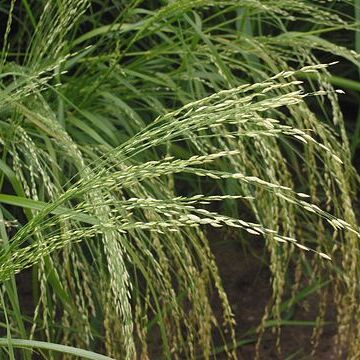Spikelets 5.5–9 × 1.5–2 mm, narrowly oblong, lightly laterally compressed, 4–12-flowered, the florets remaining intact for some time on the persistent rhachilla, very tardily deciduous; glumes unequal, reaching to about the middle of the adjacent lemmas, keeled, lanceolate in profile, glabrous, subacute to acute or acuminate at the apex, the inferior 1.2–2.5 mm long, the superior 1.7–3 mm long; lemmas 2–2.7 mm long, keeled, oblong-elliptic to oblong-ovate in profile, thinly membranous with distinct lateral nerves, at first appressed to the rhachilla and those in opposite rows with overlapping margins concealing the rhachilla, later diverging and exposing the rhachilla as the caryopsis swells, straw-coloured to dark green or reddish, glabrous, subacute to acute at the apex; palea very tardily deciduous with the lemma, glabrous on the flanks, the keels slender, wingless, scaberulous; anthers 3, 0.3–0.6 mm long.
Annual; culms 20–90 cm. high, erect.. Leaf-blades flat, up to 30 cm. long and 4 mm. wide.. Panicle lanceolate to broadly ovate, 10–40 cm. long, diffuse or contracted, with slender pedicels and long flexuous branches of which the lowest form a whorl, the axils hairy or glabrous.. Spikelets 4–12-flowered, narrowly oblong, 5.5–9 mm. long, 1.5–2 mm. wide, straw-coloured to dark green or reddish, the florets at first appressed to the rhachilla, but diverging as the grain swells, remaining intact at maturity; glumes lanceolate, acuminate, unequal, the lower 1.2–2.5 mm. long and 0–1-nerved, the upper 1.7–3 mm.; lemmas oblong-elliptic, 2–2.7 mm. long, acute; palea scaberulous on the keels, eventually falling very tardily with the lemma; anthers 3, 0.3–0.6 mm. long.. Caryopsis oblong, 1–1.2 mm. long, turgid, white or reddish brown.. Fig. 60/11, p. 190.
Loosely tufted annual to 600 mm high, erect. Leaf blade to 300 x to 4 mm. Inflorescence open or contracted; branches usually more than 40 mm long, flexible, slender; lowest branches whorled; pedicels slender, flexuous. Spikelet 5.5-9.0 x 1.5-2.0 mm; rachilla persistent, tardily deciduous; lemmas and paleas remaining intact for a time; glumes unequal; lower glume reaching from 1/2 to longer up lemma above; upper glume 1/2-2/3 the length of lemma above; lemma 2.0-2.7 mm long, lateral nerves distinct; apex acute to subacute, membranous; palea keels scaberulous; anthers 3, 0.3-0.6 mm long; caryopsis oblong, turgid.
Loosely tufted, erect annual, up to 600 mm high. Leaf blade up to 300 x 4 mm; ligule a fringe of hairs. Inflorescence an open or contracted panicle; branches usually > 40 mm long, flexible, slender; pedicels slender. Spikelets 5.5-9.0 x 1.5-2.0 mm, laterally compressed; rachilla persistent, lemmas and paleas remaining intact at maturity; glumes shorter than spikelet; 1-nerved. Florets many; lemmas 2.0-2.7 mm long, entire, 3-nerved; palea keels scaberulous; anthers 3, 0.3-0.5 mm long. Flowering time Nov.-May (July, Sept. Caryopsis oblong.
Annual, loosely tufted (erect), up to 0.6 m high. Leaf blades up to 300 mm long, up to 4 mm wide. Spikelets 5.5-9.0 mm long, 1.5-2.0 mm wide. Inflorescence open or contracted, branches usually longer than 40 mm, flexible and slender, pedicels slender; spikelets with rhachilla persistent and lemmas and paleas remaining intact at maturity; upper glume half to two-thirds the length of lemma above in intact spikelet; lemmas 2.0-2.7 mm long; palea keels scaberulous; anthers 3, 0.3-0.5 mm long. Caryopsis oblong.
Annual; up to 0.6 m high; loosely tufted; erect. Leaf blades up to 300 x 4 mm. Flowers: panicle open or contracted; branches usually > 40 mm long; flexible and slender; pedicels slender; spikelets 5.5-9.0 x 1.5-2.0 mm; spikelets with rachilla persistent and lemmas and paleae remaining intact at maturity; glumes unequal; upper glume 1/2-2/3 length of lemma above in intact spikelet; lemmas 2.0-2.7 mm long; palea keels scaberulous; anthers 3; 0.3-0.6 mm long; caryopsis oblong.
A millet grass. It is an annual tufted grass. It grows 60-120 cm tall. It has a slender stem and long narrow smooth leaves. The flowers occur in loose open panicles. These are 15-35 cm long. The branches are very thin and droop over. The seeds are very small. They are 1-1.5 mm long. There are about 2500-3000 seeds per gram. A brown seeded and a white seeded kind are recognised.
Panicle 10–40 cm long, lanceolate to broadly ovate, diffuse or contracted, the spikelets evenly distributed on slender flexuous pedicels 4–9 mm long, the lowermost primary branches in a whorl, the remainder not so, terminating in a fertile spikelet, glabrous or thinly long-pilose in the axils, slender and flexuous, eglandular.
Loosely caespitose annual; culms up to 90 cm tall, usually erect, branched or unbranched, glabrous at the nodes, eglandular; leaf sheaths glabrous; ligule a line of hairs; leaf laminas 6–30 cm × 2–4 mm, linear, flat or involute, glabrous, eglandular.
Caryopsis 1–1.2 mm long, oblong, turgid, white or reddish-brown, usually retained on the mature panicle.

